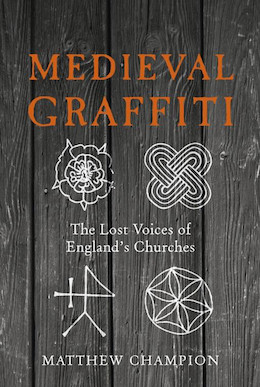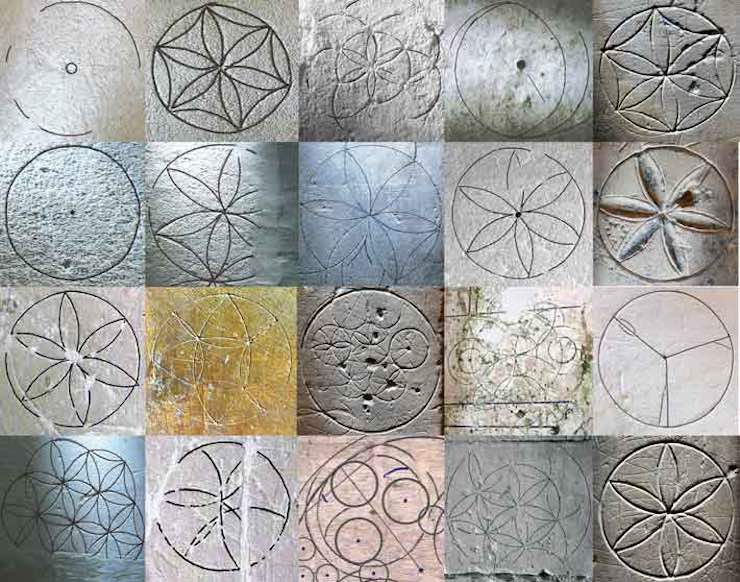The more we learn about medieval graffiti, the clearer we can envision the daily lives of people from centuries ago: students scribbling irreverent doodles in the margins of illuminated manuscripts, scribes bemoaning the effects of too much ale on similarly ancient pages. It may not surprise you to learn that manuscripts weren’t the only places people left hints of their daily hopes and woes—churches bore similar signs, ranging from daisy wheels to crosses to “witch marks.” The latter is especially interesting because it was a type of ritual protection that today we would more associate with pagan practices than with Christianity.
 These witch marks are among the various forms of graffiti that archaeologist Matthew Champion uncovered and studied for his book Medieval Graffiti: The Lost Voices of England’s Churches. He writes, “[T]he medieval church was a far more interactive space than we may have once believed,” pointing to the collections of charms, curses, prayers, word puzzles, and drawings of ships, demons, and knights battling dragons. Moreover, the hands that etched these messages belonged to a variety of people associated with the church: those who physically built it to a lord from a nearby manor to the parish priest himself.
These witch marks are among the various forms of graffiti that archaeologist Matthew Champion uncovered and studied for his book Medieval Graffiti: The Lost Voices of England’s Churches. He writes, “[T]he medieval church was a far more interactive space than we may have once believed,” pointing to the collections of charms, curses, prayers, word puzzles, and drawings of ships, demons, and knights battling dragons. Moreover, the hands that etched these messages belonged to a variety of people associated with the church: those who physically built it to a lord from a nearby manor to the parish priest himself.
Champion also found more than one pentangle (or, as we know it, a pentagram). A recent piece on Hyperallergic points out that magic was more intertwined with Christianity than we might have thought, in the form of deeply-held folk beliefs and traditions. Champion explains that “these symbols represent a level of folk belief that permeated the whole of medieval society, an aspect of religious belief that, taken in context, was as central to the everyday lives of the medieval commoner as the next meal, the next harvest and the next year.”
For instance, take these floral designs, which were often found on and around baptismal fonts:

“Christianity was not the warm and fluffy religion that it is today,” Champion told Archaeology.org. “People believed in the power of evil, and would do everything they could to ward off the ill forces that lurked outside the church door.” Such as drawing these intricate designs intended to trap evil spirits within their interlocking circles and shapes.
Imagine that—medieval parishioners carving symbols into the walls of their churches as a form of protection and an expression of faith.











I’ve long thought the apotropaic marks in churches and inside buildings are fascinating, not least because they were being carved quite recently, and yet we’ve little idea what symbolism they held for the people who carved them, especially the more abstracted shapes. There’s a lot of guesses, but not much in the way of first-hand interviews or collected lore. The marks that are put in hard-to-see places, or hard-to-reach places are curious because they seem to have required a lot of effort, and weren’t seen by anyone. The repeated, frequently used and widely dispersed patterns and symbolism suggests that common magical ideas were at play, but again, we’re not exactly sure what those ideas were.
This is similar to the objects found inside building walls. Old single shoes in a pile (usually the left shoe), or half-cut pieces of clothing, or perhaps most creepily, sometimes mummified cats positioned so that they are chasing mummified mice. There’s a movie theatre in Victoria Australia that has a mummified cat on display that was found in the walls–but the theatre isn’t that old, from memory, it can’t be much older than 1930… so people were (if memory serves correctly) still killing cats and setting them up inside the walls of buildings in the 1930s. The reason why this had to be done must have been quietly passed from one person to another, because once it died out as a practise, it really died out–now we don’t have any clear idea why anyone even did it. Again, there are guesses about protecting the building–maybe the rats represent ‘spiritual vermin’–but the exact reasons remain murky.
Anyway, the book looks interesting. Will likely get hold of a copy.
Chris
I’ve read that while the witch trials turned up a lot of fantasy and torture-avoidant fabulation, familiars were part of pre-existing folk belief. Recasting familiar spirits as minions of the Devil was a new twist on an old tradition.
@1 Chris
A lot of the decorative work in mediaeval cathedrals was placed where it would be difficult, if not impossible, for the average parishioner to see it, or even know it was there. God, the saints, and the heavenly host, however, would have no such troubles. Also, the display of skill and the effort expended in producing these carvings was offered up to God, and it didn’t matter if anyone else knew – it was the effort and intent that counted, the same as with a good deed that nobody else would ever know about. Could the same sort of thinking apply to these markings that were placed out of sight? Not that anything divine was necessarily the intended audience, of course.